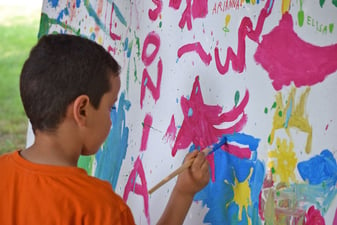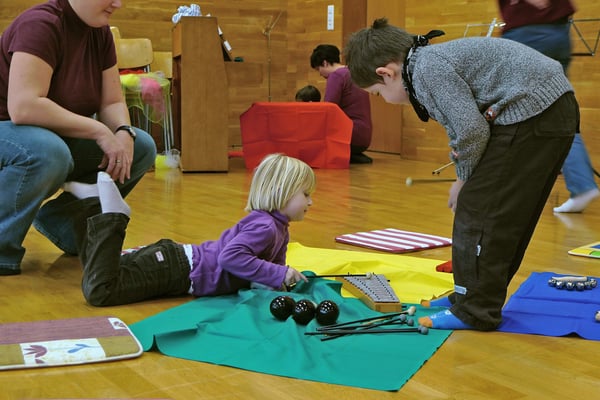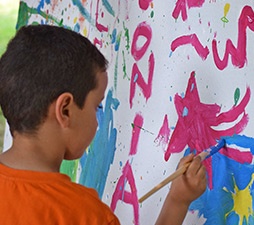Autism and Art Therapy: Four Beneficial Treatment Options
Finding the Form of Art Therapy That Works Best for Your Child
For more than 70 years, creative arts therapies such as visual art therapy, music therapy, dance therapy, and drama therapy have been used in psychotherapy or counseling with individuals of all ages, particularly children. A credentialed professional who has completed an approved program in a specific creative arts therapy specialization can help build life skills and promote healthy self-expression in children with autism. Often used in conjunction with behavioral treatments and medication, these alternative or complimentary creative arts treatments have a broad range of options available.
Sin ce one of the hallmarks of autism is impaired communication, creative arts therapies are a natural fit for autism. They can be a way for children to express themselves nonverbally, whether through images, sounds, or their bodies. Working alongside a therapist rather than having one-on-one conversations may be more comfortable for some children and help build a powerful bond through art-making. Treatment can also encourage verbal communication as therapeutic relationships develop. Since children get enjoyment, stress relief, and self-confidence from tackling artistic challenges, creative arts therapies can also help children practice skills and positively reinforce improved sensory, social, and emotional functioning.
ce one of the hallmarks of autism is impaired communication, creative arts therapies are a natural fit for autism. They can be a way for children to express themselves nonverbally, whether through images, sounds, or their bodies. Working alongside a therapist rather than having one-on-one conversations may be more comfortable for some children and help build a powerful bond through art-making. Treatment can also encourage verbal communication as therapeutic relationships develop. Since children get enjoyment, stress relief, and self-confidence from tackling artistic challenges, creative arts therapies can also help children practice skills and positively reinforce improved sensory, social, and emotional functioning.
Individual approaches to creative arts therapy have specific characteristics that make some more appropriate than others for addressing the particular goals of different children who have autism.
Art Therapy
Art therapy is the purposeful use of visual arts materials to promote mental and emotional growth. People with autism are often highly visual thinkers so expressing feelings and ideas through images may be very natural for some children.
One of the most common goals of art therapy is to increase tolerance for unpleasant stimuli while channeling self-stimulating behavior into creative play. Since art is naturally enjoyable for almost all children, it can encourage children with autism to tolerate materials with texture or smells they would otherwise avoid. When working on a papier-mâché craft project, for example, a child might find that he or she is able to cope with handling slimy strips of paper. The goal is for children to eventually become desensitized to similar sensations until they become bearable in daily life.
Since people with autism may struggle with understanding other people’s perspectives, art can facilitate forming connections with peers since it offers a concrete way to see another person’s point of view. Additionally, compulsive behaviors can be channeled into self-expression and enjoyment.
Music Therapy
Music therapy is the evidence-based use of music interventions in a developmentally appropriate manner to impact behavior and facilitate skill development. Individuals with autism often respond positively to music and show a heightened interest in the medium, making it a particularly effective tool for working with them.
Due to its flexibility, music can be adapted to meet the needs of each individual. The structured and sensory nature of music can help establish role expectations and positive interactions. Often, music assists with the development of verbal communication since listening and responding to another person requires turn-taking and shared play. With defined target objectivities that address identified individual needs, music therapy can promote relatedness, relaxation, learning, self-expression, and motivation in children with autism.

Dance Therapy
Dance Therapy utilizes elements of dance and movement as methods for therapeutic assessment and intervention. Unlike dance classes, where individuals learn steps or routines, dance therapy seeks to channel movement and expression into forming relationships.
Movement is an entry point that helps therapists learn how an autistic child processes information and communicates with his or her body. Using the movements of the autistic child as cues, dance therapists can meet the child with his or her language. This initial communication through the body can lead to verbal expression. By first understanding the child, dance therapists can channel the child’s repetitive and restrictive behaviors toward creative communication and social relatedness.
Drama Therapy
Drama Therapy uses theatre techniques to create a safe space to work through individual issues and find alternative solutions to them. For some verbal children or adults with autism who struggle to speak and interact socially, drama therapy can be particularly effective. Sometimes children with autism can recite big chunks of dialogue from TV shows and movies. Drama therapy can offer such individuals opportunities to productively use their imitative strengths in a supportive setting.
Participants are also encouraged to practice social skills, work on understanding and using body language, develop speaking skills, and build confidence through performance. Many games that are used with theatre students can be easily modified for learners on the autism spectrum.
Finding A Creative Arts Therapist
The resources below are from established creative arts therapy associations and can support you in finding treatment for a child with autism.
-
Art Therapy & Autism Spectrum Disorder: Integrating Creative Interventions
http://www.arttherapy.org/upload/autismtoolkit.pdf
The Autism Society of America joined with the American Art Therapy Association to develop a toolkit with art therapy information and resources for healthcare professionals as well as individuals on the Autism Spectrum, their families, and caregivers. The toolkit offers guidelines for finding qualified art therapists and identifies model art therapy programs.
-
How to Find a Music Therapist
http://www.musictherapy.org/about/find/
The American Music Therapy Association (AMTA) is the professional association for music therapists. The AMTA website offers an introduction to music therapy and its uses in various settings as well as information on reimbursement and an email address to contact if you are interested in locating a music therapist.
-
Find a Dance/Movement Therapist Directory
The American Dance Therapy Association is the only U.S. organization dedicated to the profession of dance/movement therapy. The organization offers a directory for finding therapists by state.
-
Drama Therapist Practice Listing
http://www.nadta.org/what-is-drama-therapy/find-a-drama-therapist.html
The North American Drama Therapy Association (NADTA) maintains requirements that must be met to qualify as a registered drama therapist (RDT). NADTA promotes drama therapy through information and advocacy. The organization offers a drama therapist practice listing for those who are interested in finding a drama therapist.

Grace Chen
Grace Chen is currently pursuing an Ed.M. in Arts in Education at Harvard Graduate School of Education. She has been a teaching artist, curriculum developer, and research assistant focusing on innovative evaluations in out-of-school time programs. She hopes to develop resonant and empowering art programs by partnering with youth in educational research and practice.





